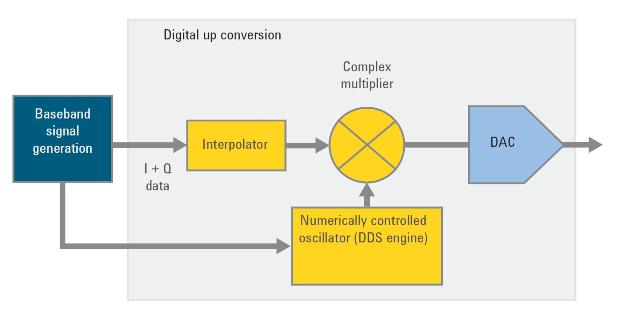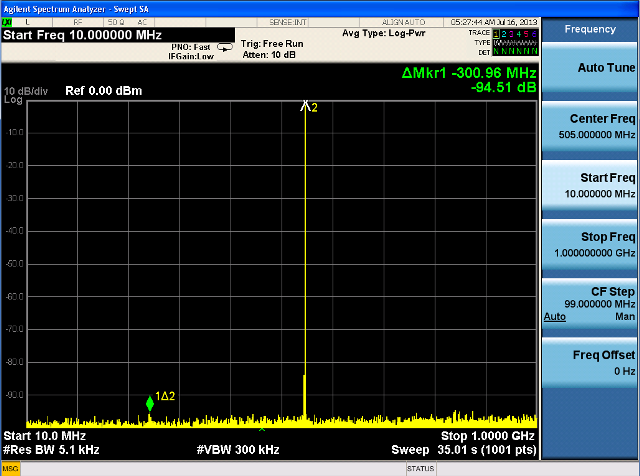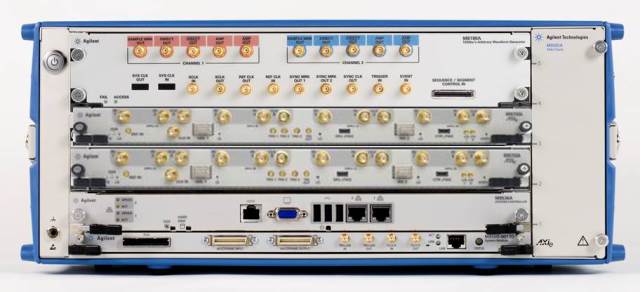BY BEATE HOEHNE
Product Manager
Agilent Technologies
www.agilent.com
The game of leapfrog continues between the bandwidth needs of wireless services — such as on-demand video — and the bandwidth capacity of wireless components, devices, and infrastructure. For developers and manufacturers, this has implications that extend to the test equipment needed for design, troubleshooting and testing.
Among the instruments needed for these tasks, an arbitrary waveform generator (AWG) is the most versatile generator of all the different signals necessary to represent the environment required for testing, the so-called “signal scenario.” The latest generation of AWGs provides wide bandwidth and high dynamic range simultaneously, making it possible to cover multiple applications and test requirements.
Necessary but insufficient
In many wireless applications, realistic testing requires complex signal scenarios and long play times. Many AWGs are available with on-board waveform memory that ranges from 2 to 16 Gsamples, and this may seem like plenty of space for waveforms.
Reality shows that there is never enough memory. One reason: As the sampling rate of an AWG increases, playback time generally decreases. For example, a 50-Gsample/s signal and a 16-Gsample memory equates to just 320 ms of play time — clearly inadequate when a growing number of tests call for minutes-long signals.
For applications that need a repetitive signal, enhancing an AWG with basic sequencing capabilities is sufficient to extend waveform play time. However, this approach falls short for tests that require dynamic signals that change based on external events. Also, many AWGs are unable to make on-the-fly changes without halting the output signal, downloading a new waveform, and restarting the output.
New techniques, heightened realism
It is possible to benefit from a high sampling rate without giving up the benefits of a large waveform memory. For example, playback time can be improved by downloading low-sampling in-phase/quadrature (I/Q) data into memory, and then generating a high-sample-rate intermediate-frequency (IF) signal. This type of operation is typically implemented using a numerically controlled oscillator, such as a direct digital synthesis (DDS) engine (see Fig. 1).

Fig. 1: The use of a direct digital synthesis (DDS) engine ensures that an AWG
architecture can provide efficient use of memory while helping to extend
playback time.
In addition, waveforms and their attributes can be stored independently. That is, instead of storing multiple versions of a waveform, its basic shape can be saved just once, and the variations stored separately in a table. The sequencer function controls the merging of the parameters with the waveform in real time. (The Agilent M8190A and M9330A AWG are examples of instruments that use this type of architecture.)
This highly efficient approach can also add a useful new dimension to testing that requires highly realistic signal scenarios: during runtime, waveform parameters can be changed on the fly so signal output is continuous. On-the-fly changes enable easy generation of multiple permutations of one base waveform. Thus, the AWG can respond to real-time events and generate a new signal scenario, and the resulting effect is the ability to achieve several minutes of play time. (Currently, this functionality is unique to Agilent AWGs because of their use of a proprietary ASIC.)
Streaming enables virtually endless scenarios
The next useful step is to create virtually endless scenarios. The simplest solution is to produce a continuous data stream originating from a RAID array or a solid-state disk.
The M8190A AWG is an example of an instrument that offers such a streaming solution. It can produce an uninterrupted data stream with 14-bit resolution at 8 Gsamples/s or 12-bit resolution at 12 Gsamples/s. To meet the needs of demanding wireless applications, the M8190A can produce these signals with a spurious-free dynamic range (SFDR) as good as -90 dBc (see Fig. 2 ).

Fig. 2: This single tone (generated by the M8190A) demonstrates the kind of excellent signal performance that advanced AWGs can offer.
If the AWG is operating at 12 bits and 12 Gsamples/s, the data rate required to support such signal generations is 144 Gbits/s or 18 Gbytes/s. This level of performance requires a high-end computer system, a special RAID system, or a high-performance digitizer. With a digitizer, signal data can be downloaded directly to the AWG. Implementing this configuration in a modular form factor (see Fig. 3 ) can be very convenient as well as space and cost efficient .

Fig. 3: Mounting an AWG (M8190A) and two digitizers (M9073A) in a single AXIe chassis saves space and money.
The next level of sophistication in dynamic signal scenarios is to combine streaming with deterministic timing. Precise timing control makes it possible to create cause-and-effect situations that aid troubleshooting and help designers pinpoint the source of problems in the system under test.
Advertisement
Learn more about Keysight Technologies, Inc.





